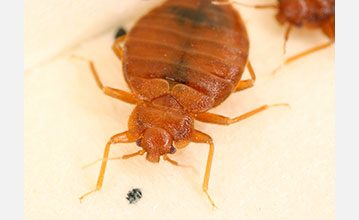Multimedia Gallery
Bed bug genome sequenced
Bed bug (Cimex lectularius).
More about this image
Research funded by the National Science Foundation (NSF) has found that the genome sequence of the common bed bug reveals the mechanisms behind the pest's ability to resist insecticides and to mitigate rough sexual insemination practices, among other characteristics.
The findings will lead to further study of some of these attributes to learn more about how to disarm the ubiquitous pest says Coby Schal, the Blanton J. Whitmire Distinguished Professor of Entomology at North Carolina State and a co-leader of the bedbug genome sequencing project.
"This paper expands to the genomic level some of the things we’ve known for a long time," Schal said. "We’ve known, for example, that bedbugs are resistant to insecticides for some time. The genome sequence shows genes that encode enzymes and other proteins that the bedbug can use to fight insecticides, whether by degrading them or by preventing them from penetrating its body."
The genome sequence also shows genes that encode whole sets of proteins that reduce the traumatic effects of bedbug copulation. Male bedbugs will try to copulate with just about every bedbug that moves, including babies and other males. Males inject a sickle-shaped appendage into a V-shaped area of the female’s abdomen called the spermalege. To counter this damaging process, females produce the protein resilin, which makes the spermalege firmer yet more flexible to adapt to harsh copulation attempts.
[Research supported in part by NSF grant IOS 10-52238.]
To learn more, see the NSF News From the Field story Researchers sequence bed bug genome, find unique features.(Date image taken: 2010; date originally posted to NSF Multimedia Gallery: Jan. 25, 2017)
Credit: Benoit Guenard
Images and other media in the National Science Foundation Multimedia Gallery are available for use in print and electronic material by NSF employees, members of the media, university staff, teachers and the general public. All media in the gallery are intended for personal, educational and nonprofit/non-commercial use only.
Images credited to the National Science Foundation, a federal agency, are in the public domain. The images were created by employees of the United States Government as part of their official duties or prepared by contractors as "works for hire" for NSF. You may freely use NSF-credited images and, at your discretion, credit NSF with a "Courtesy: National Science Foundation" notation.
Additional information about general usage can be found in Conditions.
Also Available:
Download the high-resolution JPG version of the image. (3.1 MB)
Use your mouse to right-click (Mac users may need to Ctrl-click) the link above and choose the option that will save the file or target to your computer.

